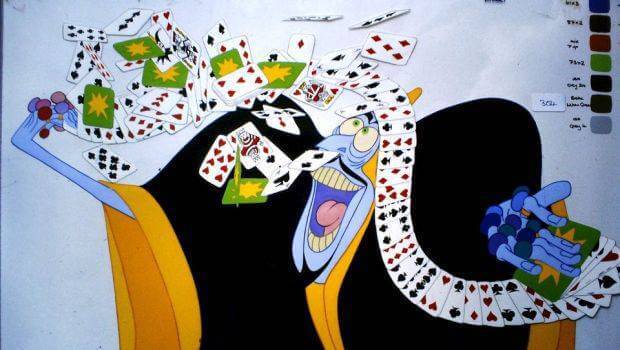Richard Williams Changes Tack
In May 1992, on the last day of production of Richard Williams’ magnum opus The Thief and the Cobbler before the film was taken off him by the Completion Bond Company, Williams’s wife and producer Imogen Sutton spirited the latest workprint out of the studio for duplication. In an event that will become a footnote in the history of animation, a digital copy of that workprint was screened at London’s BFI Southbank on Sunday afternoon.

Colour guide of Zig Zag from The Thief and the Cobbler (picture: Persistence of Vision Facebook Page)
For years Williams has famously been reluctant to even discuss the film, so to have him present it here himself, in front of an audience that had, no doubt, largely given up hope of ever seeing it in a cinema, was something of a historic moment. In his (I thought) ever-so-slightly nervous introduction, Williams recalled that Ken Harris, the veteran maestro who passed away in 1982 after working on the film for many years, hoped that he would live long enough to see the public response. “Well, Ken”, said Williams “This is it!”
It was tantalisingly close to completion… perhaps 80 percent of the film was finished and most of the rest was in pencil test. Storyboards plugged the remaining gaps, and the soundtrack had a very work-in-progress feel to it.
Last year, In a review of Kevin Schreck’s documentary about the making of this film, Persistence of Vision, I concluded that it might have trouble living up to its own legend, largely because I had a sense that Williams’ dedication to the craft of animation was not matched by his approach to writing – and yes, the story was slight, the characters bland and not particularly appealing, but the animation itself was jaw-dropping throughout. Although compromised by being a print-from-a-print, rather than from an original negative, the film was very beautiful to look at, and the level of craftsmanship in the animation itself was unsurpassed, but beyond that it played tricks with perspective, staging and choreography that no other feature animation has even come close to attempting. My attention flagged at times, feeling much as if I’d gorged myself on too many Belgian chocolates, but when we got to the climactic war machine sequence I was spellbound again. Here, for a chunk of screen time indefensible from any narrative point of view, the thief pursues his coveted golden balls, which he has spent the film trying to steal, through the inside of a massive war machine that looks like the collective fever dream of Heironymous Bosch, M C Escher and William Heath Robinson. So focused is he on his goal that he is oblivious to the fact that the machine is collapsing around him and constantly threatening to crush or mangle him. Leaving aside the curious parallel this scene has with the production itself, this is just an astonishing sequence to watch. The fact that it exists at all is a monument to human persistence, creativity and dedication in the face of, well, commercial reality. Certainly nothing like it will ever be done again – a sad thought. The Thief and the Cobbler may be less than the sum of its parts but with parts like this, how could it be otherwise?
In the discussion that followed, if was good to see Williams apparently at peace with himself over this film, and seemed to feel that this screening represented some degree of closure, even as he reflected on the conflict between what artists are driven to create and what financiers demand. He recalled for us the Golden Rule – whoever has the gold makes the rules. “You have to serve the machine, and I never could”.
In the concluding Q and A, someone asked whether Williams would like to finish the film. He replied that it couldn’t happen. The animation itself could perhaps be completed in a year but the existing materials – the negative and the artwork – were scattered to the four winds and it’s unlikely you could ever get them all back in one place. And even then the legal battles would probably make it impossible.
Williams has now, he said, been working for fifteen years on another feature, and revealed its working title: “I Hope I Live to Finish This”. Amen to that.
Listen to our interview with Richard Williams on the Skwigly podcast here.


